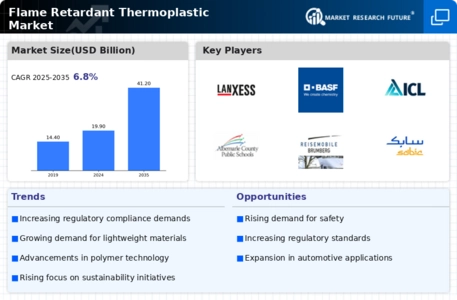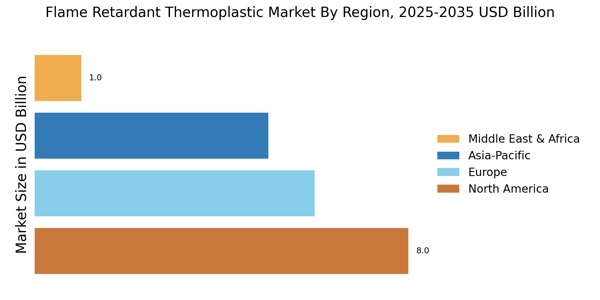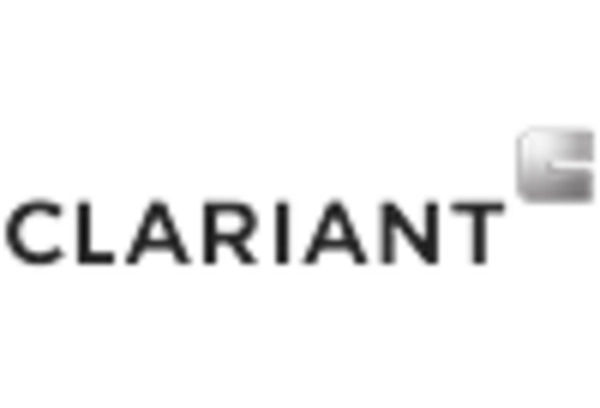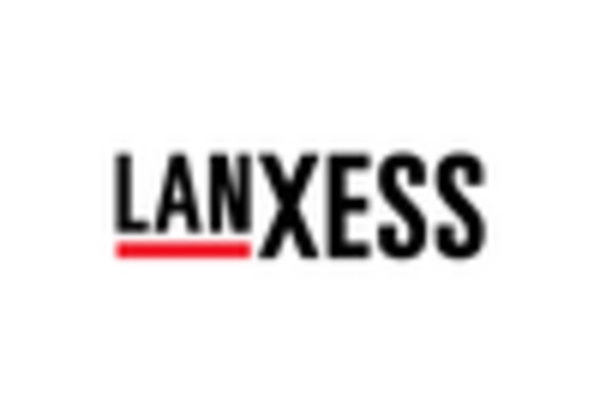Increasing Demand from Automotive Sector
The Flame Retardant Thermoplastic Market is experiencing a notable surge in demand from the automotive sector. As vehicle manufacturers increasingly prioritize safety and compliance with stringent regulations, the need for flame retardant materials has escalated. In 2023, the automotive segment accounted for approximately 25% of the overall market share, reflecting a growing trend towards incorporating flame retardant thermoplastics in vehicle interiors and components. This shift is driven by the necessity to enhance passenger safety and reduce fire hazards, particularly in electric vehicles. Furthermore, the integration of these materials not only meets safety standards but also contributes to the overall performance and durability of automotive products. As the automotive industry continues to evolve, the reliance on flame retardant thermoplastics is likely to intensify, thereby propelling market growth.
Growing Regulatory Pressure for Fire Safety
The Flame Retardant Thermoplastic Market is increasingly shaped by growing regulatory pressure for fire safety across various sectors. Governments and regulatory bodies are implementing stringent safety standards to mitigate fire hazards in consumer products, automotive, and construction materials. In 2023, the regulatory landscape has become more complex, with new guidelines mandating the use of flame retardant materials in specific applications. This regulatory environment compels manufacturers to adopt flame retardant thermoplastics to ensure compliance and avoid potential liabilities. As awareness of fire safety issues rises, the demand for compliant materials is expected to grow, driving the flame retardant thermoplastic market forward. The interplay between regulatory requirements and market dynamics is likely to create a robust framework for sustained growth in the industry.
Innovations in Flame Retardant Technologies
The Flame Retardant Thermoplastic Market is benefiting from ongoing innovations in flame retardant technologies. Research and development efforts are focused on creating more effective and environmentally friendly flame retardant additives that enhance the performance of thermoplastics. In recent years, advancements in nanotechnology and bio-based materials have emerged, offering potential alternatives to traditional flame retardants. These innovations not only improve the fire resistance of thermoplastics but also address environmental concerns associated with conventional flame retardants. As manufacturers seek to comply with evolving regulations and consumer preferences for sustainable products, the integration of these advanced technologies is expected to drive market growth. The continuous evolution of flame retardant technologies may lead to new applications and expanded market opportunities.
Expansion in Electrical and Electronics Applications
The Flame Retardant Thermoplastic Market is witnessing significant expansion within the electrical and electronics sector. With the proliferation of electronic devices and the increasing complexity of electrical systems, the demand for materials that can withstand high temperatures and resist ignition is paramount. In 2023, the electrical and electronics segment represented around 30% of the market, underscoring the critical role of flame retardant thermoplastics in ensuring safety and reliability. These materials are extensively utilized in components such as connectors, circuit boards, and housings, where fire safety is a top priority. As technological advancements continue to drive innovation in this sector, the adoption of flame retardant thermoplastics is expected to grow, further solidifying their importance in the market.
Rising Construction Activities and Infrastructure Development
The Flame Retardant Thermoplastic Market is significantly influenced by the rising construction activities and infrastructure development across various regions. As urbanization accelerates, the demand for safe and durable building materials has increased. Flame retardant thermoplastics are increasingly being utilized in construction applications, including insulation, wiring, and piping, due to their fire-resistant properties. In 2023, the construction sector accounted for approximately 20% of the market share, reflecting a robust trend towards incorporating these materials in new projects. The emphasis on safety regulations and building codes further drives the adoption of flame retardant thermoplastics, as they help mitigate fire risks in residential and commercial buildings. This trend is likely to continue, as the construction industry seeks to enhance safety standards and improve material performance.


















Leave a Comment